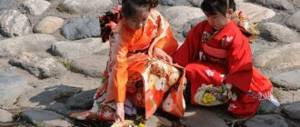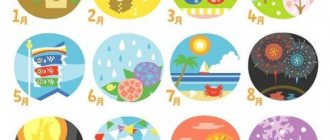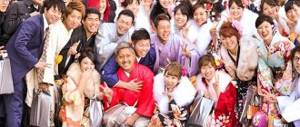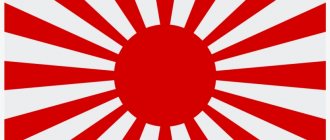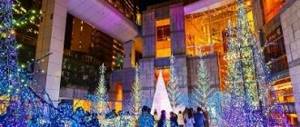Japan is a country rich in holidays. Here almost every day there is some kind of special event. Holidays in Japan are accompanied by games, competitions, dancing, singing, processions, and performances.
Numerous holidays, according to their content and origin, can be divided into groups: national, state, religious, traditional.
Ancient agricultural festivals occupy a significant place in the Japanese calendar. Holidays associated with rice cultivation are the most colorful. A number of holidays of contemplation of nature gave rise to the originality of oriental aesthetics.
Many holidays are dedicated to children. Hina Matsuri is the most famous of them.
But the Japanese, who love fun, relaxation and rich feasts, could not get by with only state-legalized national holidays. They also have Matsuri. Matsuri represent various festive processions, chants, traditional dances, fireworks, etc. So every city has its own traditional holidays - matsuri.
Public holidays in Japan
Officially, there are 15 public holidays in Japan. National holidays in Japan include: New Year (January 1), Coming of Age Day (January 15), Founding Day (February 11), Vernal Equinox Day (March 21), Greenery Day (April 29), Constitution Day (May 3), Rest Day (May 4), Children's Day (May 5), Day of Honor for the Elderly (September 15), Autumnal Equinox Day (September 21), Sportsman's Day (October 10), Culture Day (November 3), Labor Day (November 23), Emperor Akihito's birthday (December 23).
In Japan, in addition to state ones, a large number of religious and traditional holidays are celebrated, and all kinds of local festivals are also held. Let's consider the most significant and vibrant holidays.
Constitution day
Since 1948, the third of May has been an official holiday, celebrating Constitution Day.
After defeat in World War II, the Japanese authorities were forced to change the country and accept the conditions of the victorious countries. Thus, in 1947, the sovereignty of the Japanese people was recognized, the country became parliamentary, and the great Emperor became a “symbol.”
Japanese holidays and traditions often date back to ancient times, but Constitution Day is relatively new and allowed Japan to develop after defeat and become one of the most powerful countries in the world.
Hanami - cherry blossom festival
The main spring event in Japan is considered to be the blossoming of sakura, which the Japanese call hanami. This ancient Japanese tradition of viewing flowers dates back to the 7th century.
The Sakura Festival in Japan is not an official holiday, but for the Japanese it is very important and significant. A huge number of people visit and spend their time in parks, squares and alleys during cherry blossom days. Since the cherry blossom period is relatively short (about two weeks), it is admired both during the day and in the evening. And the evening inspection is especially popular.
The time of the first blossoms of the cherry blossoms growing in Yasukuni in the ancient Buddhist temple is considered to be the official starting point. Meteorological services immediately begin to notify how the very first pink flowers appear from the buds. The approximate time for the city of Tokyo and its environs is the end of March.
Ume (Japanese plum) is the very first to start this “procession” of flowers. Sakura begins to bloom after Uma.
Festival
In addition to the lantern procession, fireworks are an integral part of the festival. The scale with which the Japanese approach this part is amazing. The patterns that appear in the night sky excite the imagination. But it is useless to describe such a phenomenon; it needs to be seen once rather than heard or read a hundred times. Even photographs and videos will not be able to fully convey the effect.
Lanterns on the water
Spring Festival in Japan
Setsubun is the four special days in the Japanese calendar that separate spring, summer, autumn and winter. These days, the Japanese perform purification rituals. Spring Eve, the time when nature awakens, is the most important of the four holidays.
The Spring Festival is famous for its funny-shaped rituals. The main purpose of such rituals is to ensure prosperity for the next year and expel evil spirits. During the holiday, on the door of every house you can see a hanging sprig of osmanthus, famous for its pungent smell and thorns.
Sweet white beans are the main attributes of the holiday. Many purification rites are associated with them in Japan. First, the beans are heavily roasted over a fire, and then they are scattered throughout various rooms, especially in dark corners.
Story
The history of the Dancing Lantern Festival goes back centuries. It all started when one day Emperor Keiko and his retinue, while passing through the village of Yamaga, got lost in thick fog. To show him the way, local women attached hanging lanterns to their heads and walked in front of the imperial carriage, showing it the way. So the ruler was able to successfully leave the village. Since then, the residents of Yamaga decided to celebrate this event every year. With this holiday, the Japanese show respect for their history and the cultural heritage of their ancestors.
© t_ike930
Fertility Festival in Japan
The cult of the genital organs as a symbol of offspring and fertility has existed since ancient times in many countries. Japanese Shintoism was no exception here. At the same time, the theme of the phallus in the modern era is perceived in Japan, unlike Europe, as a natural thing, devoid of any vulgarity.
Thus, throughout the country there are many temples where female and male organs are worshiped. Moreover, this procession is not hidden; on the contrary, it is carried out with the organization of mass festivals, which attract thousands of people. Kanayami is one such temple.
A fertility festival called Honen Matsuri is held annually in mid-March and is celebrated throughout the country. The Japanese (usually childless women and men) come out in procession holding wooden penises of various sizes in their hands, asking for good harvests, sexual strength and many children.
Shinto shrine maidens open mass ceremonies with the dance of Young Miko.
On this day, the Japanese drink a lot of sake, as this drink is considered a symbol of the harvest. Participants buy various souvenirs and food in the shape of phalluses.
Sendai city. Tanabata Festival of Separated Lovers
The Tanabata Festival is held in the city of Sendai from August 6th to 8th. Giant poles, more than 10 meters high, are installed throughout the city, they are decorated with thin strips of paper with cherished wishes. Each district of the city competes with each other in the beauty and size of festive poles. The holiday came to Japan from China.
According to legend, the star Vega, the weaver, was forbidden to be with the star Altair, the shepherd. They were separated on opposite sides of the Milky Way. And only on the evening of July 7 (according to the old calendar) could they meet again. The name "Tanabata" is made up of two characters meaning "seven" and "evening". The holiday is spread throughout Japan, and in the city of Sendai it has been celebrated for 220 years, and it is here that the most grandiose celebrations take place, attracting more than 2 million tourists to Sendai every year.
Lantern Festival in Japan
The Kanto Matsuri Festival is one of the most vibrant and spectacular festivals in Japan. It is celebrated annually from August 4 to 7 in the northeast of the country in the city of Tohoku. This tradition originated during the Edo era (mid-18th century). Then the peasants suffered from disease and hunger. And Kanto Matsuri was that holiday when people asked for a good harvest, long life and health. Special designs were made for the holiday: many lanterns were hung on bamboo branches. These designs had their own name - Kanto. A sprouted rice sprout symbolized each Kanto.
In the 19th century, the lantern festival gained great popularity. So, processions with lanterns began to take place on the streets of the city. The culmination of the holiday was that each participant carrying Kanto tried to lift it up as high as possible. And today, a very important role is played not by how participants can raise their Kanto quickly and high, but by how they will do it.
Usually the lantern festival begins when evening falls in the city. Thousands of people come out of their homes to admire the solemn procession. Men carrying huge Kanto, to the sounds of music and screams of spectators, demonstrate extraordinary skills of dexterity and balance: they climb onto each other’s shoulders, while not letting go of the Kanto from their hands, put it on their foreheads, throw poles from their hands to their hips, and much more. The festival participants really work wonders.
The placement of the flashlights is very important for maintaining balance. Therefore, symmetry must always be maintained in the design. The lanterns depict the professions of the Kanto owner, as well as symbols of the area.
Usually about three thousand people take part in the festive procession, carrying 200 large Shiites in their hands.
Bon-odori dances
Another element of the O-Bon holiday is the traditional Bon-odori dance, also intended for meeting, commemorating and seeing off the souls of ancestors. The venue for the dance can be Buddhist temples or city squares. Nowadays, bon-odori is not only one of the rituals of remembrance of the dead, but also an integral part of summer holidays in various localities. The dancers either gather in a circle, moving in time to the accompaniment of Japanese drums (for example, gujo-odori in Gifu Prefecture), or parade through the streets of the city (awa-odori in Tokushima Prefecture).
Traditional dance is not necessarily performed to a traditional tune. Judging by the results of a survey of the well-known information site ORICON STYLE, the rating of popular melodies for bon-odori was topped by the song of the peoples of the northern island of Hokkaido, soran-bushi, studied at school, in second place is the song often heard at baseball and football matches in Tokyo Ondo, in third place is a melody from the cartoon about children's favorite robot cat Doraemon.
Bon-odori dance
In South American countries, the word “bon-odori” has entered the vocabulary of local residents no less firmly than “sushi” and “karaoke”. Every year, a major event is held in the suburbs of the Argentine city of La Plata with the participation of more than ten thousand people. Dressed in summer yukata, Argentines of Japanese, Spanish and Italian descent dance until the night, while festival guests stroll among countless mobile restaurants and have fun.
BON ODORI 2013 La Plata
The simplicity and repetitive nature of the movements of the bon-odori dance makes it accessible to any participant, and the summer version of the kimono - yukata - becomes an additional element that allows you to feel involved in the atmosphere of traditional Japan. Round dances to drum music and veneration of ancestors are another connecting link that unites the inhabitants of the northern and southern hemispheres of our planet, so distant and different at first glance.
Banner photo: Bon-odori dance
Photos provided:
Mukaebi in Numazu City (Shizuoka Prefecture): Locals light lights on the seashore. ©Batholith
Chrysanthemum Festival in Japan
One of the most ancient and important holidays in Japan is the Chrysanthemum Festival, which is celebrated in the 9th lunar month. It was the ninth lunar month in the traditional Japanese calendar that was called the month of chrysanthemums.
The chrysanthemum flower occupies a special place in the life of the Japanese. The chrysanthemum is a symbol of the Japanese imperial house. The image of this flower can be seen on the covers of Japanese foreign passports, on the attributes of politicians, on the premises of parliament, in diplomatic institutions, on coins, and on the imperial seal. This flower is also considered a symbol of longevity.
During the Chrysanthemum Festival, Japanese florists create huge dolls from living chrysanthemums. These are mainly characters from literary works, legendary heroes and real historical figures.
Also on this day, various dishes and drinks are prepared from chrysanthemums: wine, tinctures, salads, flower-shaped sweets and much more.
Green Day
Another holiday associated with the legendary Emperor Showa was Greenery Day in Japan. The Fourth of May is a holiday for the Japanese. This event is associated with the former Emperor's love for green spaces and trees. During Emperor Showa's travels around the country, his subjects planted new trees in the villages.
However, for the Japanese themselves, this is one of the holidays whose history they do not delve into. So, until 2007, Greenery Day was not celebrated on the fourth of May; the holiday did not have an exact date at all.
Mothers Day
Traditional Japanese holidays include Mother's Day. On the tenth of May, every Japanese family congratulates their mothers. Although in recent years this holiday has become just a way to sell more gifts for dear mothers.
A week before the holiday, so-called gifts for mothers are put up for sale in Japan: aprons, bags, dresses, wallets, cosmetics, perfumes, etc. Advertisements for brands offering discounts and gifts are shown on television.
But regardless of this, all Japanese revere their mothers. They believe that mothers are the center of every family and the entire society as a whole.
Children's Day
Children's Day, or the so-called Boys' Day in Japan, is celebrated on May 5th. All over the country, flags with koi nobori - carp - are flying.
According to ancient legend, a koi carp living in a deep, swampy pond was able to overcome all obstacles and cross the Dragon Whirlpool Falls. After that, he changed: a simple carp became a dragon and ascended to the distant skies.
It is for its strength and resilience that the image of a carp is used in celebration. So the boy must follow the example of the fish and turn into a real man.
sake day
Holidays in Japan in October begin on the first of October - Sake Day.
Sake is the national alcoholic drink of Japan. The process of preparing it is long and difficult, even taking into account the automation of the process. Sake is made from rice, and the resulting drink contains from thirteen to sixteen percent alcohol.
Sake is traditionally poured into choko, forty-milliliter clay cups. The bottle has a volume of one g, which is equivalent to 180 milliliters.
The Japanese try to adhere to the rules when drinking sake. Drink easily and with a smile. Take your time and maintain your individual rhythm. Know your norm and snack.
